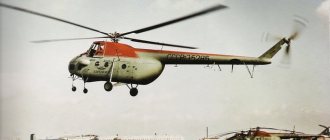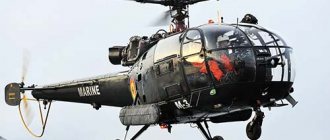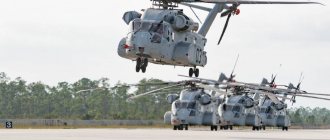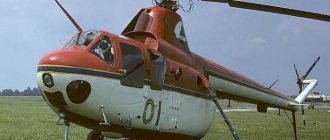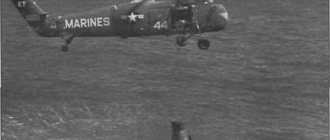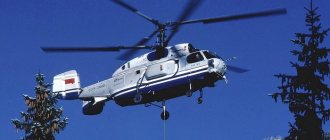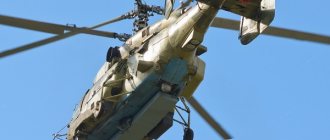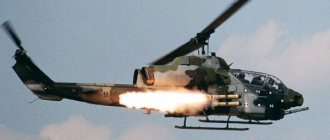The UH-60 Black Hawk helicopter is the United States Army's primary transport and attack twin-engine medium-lift helicopter. It is equipped with one 4-blade main rotor and one 4-blade tail rotor. The main crew of the UH-60A consists of three people: a pilot, a co-pilot and a flight engineer. The titanium-core rotor blades are resistant to up to 23 mm anti-aircraft artillery fire and are equipped with pressure sensors capable of detecting loss of rotor pressure (damage).
Specifications
UH-60L Black Hawk helicopter
- Manufacturer:Sikorsky
- Service: US Army (major, as well as in more than 30 countries)
- Passenger capacity: seats for 11 soldiers or 6 seats for recumbents
- Length: 19.76 m
- Height: 5.13 m (with tail rotor)
- Main rotor diameter: 16.36 m
- Tail rotor diameter :
3.35 m
Helicopters
UH-60 Black Hawk. Multi-purpose helicopter. (USA)
The UH-60 Black Hawk is a multi-role helicopter. Created by the American company Sikorsky. The helicopter is in service with the American Army, where it replaced the famous Bell UH-1, which is one of the symbols of the Vietnam War. The new rotorcraft was designed to transport 11 military personnel in full equipment. A prototype of the helicopter took to the skies on October 17, 1974, and on December 23, 1976, the helicopter won a competition announced by the military and was put into mass production. The helicopter is still in production. Since 1977, more than 4 thousand UH-60 Black Hawk helicopters of various modifications have been produced. The helicopter is familiar to the general public from the feature film “Black Hawk Down,” which tells about the events in the capital of Somalia in 1993.
The development of the UH-60 helicopter began after the US military awarded Boeing-Vertol, Bell, Lockheed and Sikorsky the task of designing a multi-role tactical helicopter intended for supplying troops on the battlefield and conducting amphibious operations. The helicopter was created as part of the UTTAS - Utility Tactical Transport Air System (multi-purpose tactical transport helicopter) program. The new multi-role helicopter was supposed to replace the Boeing-Vertol CH-46 “Sea Knight” transport helicopter, which is in service with the Marine Corps, as well as the Bell UH-1 multi-role army helicopter, which is in service with the army. In 1971, the military decided on the requirements for the future vehicle: it was necessary to transport a rifle squad of 11-15 people in the helicopter cabin; crew up to 3 people; ensuring the ability to transport the helicopter without disassembly on Lockheed C-130 and C-141 aircraft; equipping the machine with two engines.
UH-60 Black Hawk. Multi-purpose helicopter. (USA)
The initial production program included 1,100 helicopters and was planned to be completed by 1985, at that time the program was the largest helicopter program of the US Army. The cost of the entire UTTAS helicopter program, including the development, acquisition and operation of the machines for 10 years, was initially estimated by the US military at $2.4 billion, but then increased to $6.5 billion, and the price per machine increased accordingly from 2 to 5.8 million dollars. In 1972, the military issued performance requirements for UTTAS helicopters and technical specifications to 9 manufacturing companies.
Of the 9 helicopter companies that presented their UTTAS helicopter projects, the Pentagon selected the developments of Sikorsky and Boeing-Vertol, which were to provide prototypes. According to the contract, the construction of batches of 4 experimental helicopters from each of the companies was provided. One helicopter was intended for static testing, and another 3 helicopters were intended for flight testing. After the military decided on a manufacturing company, it was planned to build 5 more experimental helicopters so that all 8 machines could take part in operational tests.
In 1973, the UTTAS helicopter, developed for the military by Sikorsky, received the designation S-70 (in-house) and the army designation UH-60A. An experienced helicopter - YUH-60 first took to the skies on October 17, 1974. After evaluation tests of prototypes were completed in 1976, the US military conducted a comparative analysis of helicopters from Sikorsky and Boeing-Vertol and chose the Sikorsky helicopter. The main reasons for choosing the Sikorsky UH-60A multi-role helicopter were lower operating costs over a 20-year design period and lower technical risks.
UH-60 Black Hawk. Multi-purpose helicopter. (USA)
The fuselage of the helicopter is semi-monocoque, all-metal, made of light alloys. Composite materials based on Kevlar and fiberglass are used in the construction of the cockpit, doors, fairings, canopies and engine hoods. The fuselage has a shockproof design that can withstand overloads of 10g in a vertical impact and 20g in a frontal impact. The rear part of the vehicle's fuselage smoothly transitions into a tail boom with an asymmetrical profile and an upwardly bent end beam, to which the tail rotor and stabilizer are attached. The stabilizer is straight, controlled, its span is 4.37 m. The installation angle is changed using a control system that receives signals about the collective pitch angle, airspeed, lateral acceleration and angular velocity. For ease of transportation and during parking, the tail boom can be folded.
The entrance to the double cockpit is through 2 side doors, which are resettable. The pilots' seats are armored. The cargo cabin of the helicopter has dimensions of 4.95 x 2.21 x 1.87 m, its volume is 11.6 cubic meters. There are sliding doors measuring 1.5 x 1.75 m on both sides of the cargo cabin. The helicopter’s cargo cabin can easily accommodate 11 soldiers with their weapons or 6 wounded soldiers on stretchers.
The helicopter landing gear is three-legged, non-retractable, with one wheel on each leg. The main landing gear is of the lever type and is equipped with two-chamber shock absorbers. The pneumohydraulic shock absorption system installed on the helicopter allows for the absorption of the energy of an impact on the ground with the resulting overload of 40 g without the helicopter fuselage touching the ground. The helicopter landing gear base is 8.83 m, the chassis track is 2.7 m.
UH-60 Black Hawk. Multi-purpose helicopter. (USA)
The main rotor of the helicopter is four-bladed, the blades are hinged. The bushing is monolithic, made of titanium alloy and has dampers and elastomeric bearings that do not require lubrication. This in turn allows for a 60% reduction in maintenance work. Helicopter blades have a rectangular shape in plan, have oval-section spars made of titanium alloy and a tail section in which Nomex honeycomb filler is used. The trailing edge, as well as the butt part of the blades, are made of graphite-based composite materials. The blades are covered with fiberglass, and the counterweights installed along the toe of the blade are also made of this material. The helicopter's blades are designed according to the principle of a safe damage design, thanks to which they are able to withstand hits from 23-mm artillery shells. The blades are equipped with an electric anti-icing system.
The helicopter's tail rotor is also four-bladed, its diameter is 3.35 m, and the blades are hinged. Together with the end beam, the tail rotor is tilted sideways at an angle of 20 degrees, which allows you to increase the centering range and create a vertical component of thrust. The sleeve consists of 2 cross-shaped beams. In terms of plan, the blades are rectangular in shape, made using a composite graphite-epoxy material, just like the main rotor blades have an electric anti-icing system.
The helicopter's power plant includes 2 General Electric T700-GE-700 turboshaft gas engines, which are located in nacelles on both sides of the main rotor pylon. The maximum power of the T700-GE-700 engine was 1285 kW. This engine was developed taking into account the requirements that were obtained during the experience of operating helicopters in Vietnam. The vehicle's fuel system consisted of standard internal fuel tanks with a capacity of 150 liters; in addition, it was possible to install another internal tank with a capacity of 440 liters. In the NN-60 and MH-60 helicopter versions, drop tanks with a capacity of 870 liters could be mounted on high-mounted wing-shaped pylons. The maximum possible fuel supply of a helicopter is 3545 liters.
The helicopter control system is hydraulic, booster, redundant. The helicopter has a 67 kW Solar auxiliary power unit. It ensures the start of the main engines, as well as the drive of the hydraulic system.
The main elements of the vehicle's navigation system were an inertial navigation system and a Doppler radar. Initially, it was possible to install a system for determining the location of a helicopter using satellites. The equipment provided for helicopter defense includes an automatic dissipator of IR reflectors and tracers, as well as an ARP-39 radar receiver.
Today, without any exaggeration, we can say that the Black Hawk is a combat vehicle of the 21st century, despite the fact that it is already more than 40 years old. As a result of the development of this helicopter, a universal platform for all branches of the military was born, which, based on the totality of its characteristics, occupies a leading position in the world. In addition to the basic UH-60 land weight, 2 anti-submarine helicopters SH-60F “Ocean Hawk” and SH-60B “Sea Hawk” were developed (these helicopters are equipped with a lowered sonar station and magnetometers). The HH-60 "Rescue Hawk" helicopter was also designed, intended for military search and rescue, as well as special operations, and the MH-60 "Knighthawk" line of helicopters, which includes fire support helicopters, deck helicopters, ambulance helicopters, helicopters for carrying out special operations and jammers.
UH-60 Black Hawk. Multi-purpose helicopter. (USA)
Currently, the helicopter is still actively exported. Modern helicopter models are extremely saturated with various high-tech equipment, which in turn does not allow the aircraft to be stored outside the hangar for a long time and places high demands on maintenance personnel. The adoption of the UH-60 multi-purpose helicopter, which is actively used by all branches of the military, as well as in the navy, has significantly reduced operating costs and simplified maintenance. In the army it replaced the famous UH-1 Iroquois, and in the navy the SeaSprite. Currently, the helicopter successfully duplicates the tasks of fire support helicopters and transport vehicles, and also replaces the SH-3 “Sea King” heavy helicopters and MH-53 sea minesweepers.
Characteristics:
- Crew: 3 people (2 pilots, flight engineer);
- Passenger capacity: 11 soldiers or 6 bedridden wounded;
- Length: 19.76 m;
- Fuselage length: 16.26 m (without refueling boom);
- Main rotor diameter: 16.36 m;
- Tail rotor diameter: 3.35 m;
- Height: 5.13 m (with tail rotor);
- Area swept by the main rotor: 210.15 m²;
- Chassis base: 8.83 m;
- Chassis track: 2.705 m;
- Empty weight: 5224 kg;
- Normal take-off weight: 7907 kg;
- Maximum take-off weight: 11113 kg;
- Payload weight: 1197 kg (internal), suspended - 4082 kg;
- Fuel tank volume: 1361 l + 2 × 700 l additional tanks in the cabin (+2 × 870 l and 2 × 1703 l PTB);
- Powerplant: 2 × General Electric T700-GE-701C turboshafts;
- Engine power: 2 × 1880 hp (2 × 1402 kW);
- Maximum permissible speed: 361 km/h;
- Maximum speed: 296 km/h;
- Cruising speed: 282 km/h;
- Practical range: 584 km;
- Ferry range: 2222 km (with PTB on ESSS suspensions);
- Duration of patrol: 2 hours 6 minutes;
- Service ceiling: 5835 m;
- Static ceiling: 2330 m;
- Vertical rate of climb: 7.87 m/s;
- Disc load: 36.7 kg/m² (at normal take-off weight);
- Thrust-to-weight ratio: 328.9 W/kg (per transmission at normal take-off weight);
- Small arms and cannon weapons: in the cockpit -2 × 7.62 mm six-barreled M134 machine guns or 2 × 12.7 mm GAU-19 machine guns;
- Suspension points: 4 (2 on each side on ESSS);
- Combat load: up to 4536 kg;
- Guided missiles: air-to-surface - up to 16 × AGM-114 Hellfire, air-to-air - FIM-92;
- Unguided rockets: 70 mm Hydra 70;
- External fuel tanks: 2 × 870 l on external suspensions, 2 × 1703 l on internal suspensions.
Modifications of the "hawk"
- UH-60A Black Hawk - the first version of the hawk series
- UH-60A Credible Hawk - armored version for military rescue operations
- EH-60C Black Hawk - used in special operations to provide radio interference
- НН-60D Night Hawk - night variant of the UH-60A
- MH-60A Velcro Hawk - UH-60A modified for special operations
- MH-60A Embassy Hawk - a combat helicopter version for operations in Europe
- MH-60G Pave Hawk - a combat helicopter variant for combat rescue and special operations
- VH-60A - a helicopter version with a VIP class cabin for high-ranking officials and generals
- UH-60B - transport version of the helicopter with improved engines
- YEH-60B - modification of the UH-60A helicopter, for detecting and capturing a target before entering the enemy air defense zone
- YSH-60B - anti-submarine variant for the US Navy
- SH-60B Sea Hawk - anti-submarine version of the helicopter for searching and detecting submarines
- SH-60F Ocean Hawk - a variant designed to participate in anti-submarine operations
- НН-60J Jay hawk - a variant designed for search and rescue operations
- UH-60J - a special modification for the Japanese Air Force, adapted for rescue operations
- MH-60K - army version for special operations
- UH-60L - modified version of UH-60A
- VH-60N Presidential Hawk - an improved version for VIPs
- UH-60M - improved combat modification
- HH-60M - modified medical version
- UH-60P - a combat version of the helicopter for the Republic of Korea
- UH-60Q Dustoff Hawk - medical variant of the UH-60L
- S-70A - export version of the helicopter for Australia and Saudi Arabia
- S-70B-6 - anti-submarine helicopter version for the Greek Navy
- S-70C - a variant of civil helicopters for China and Brunei
- S-70i - export version of the UH-60 for production in Poland
- WS-70 - version built under US license in England
Presentation of participants
Mi-8
It's no joke - the world's most popular twin-engine helicopter!
In total, more than 12 thousand copies were built in various modifications. Since 1965 and to this day, Mi-8s have been flying - without exaggeration! - Worldwide. Russia, CIS countries, Asia, Africa, Latin America... Wherever a simple, convenient and inexpensive helicopter is needed, they are looking at the Mi-8. What is most captivating is its multitasking: transporting passengers, dropping troops, taking out the wounded, filling the compartments to capacity with boxes of bananas and spraying enemy trenches with unguided missiles.
Mi-8AMTSH (photo: Sergey Ablogin)
Mi-8 can do anything.
The list of its modifications and variations does not fit on one page for a long time... And even regulars of aviation forums get by with a simple Mi-8, without clarification. By the way - Mi-9, Mi-13, Mi-17, Mi-19, Mi-8AMTSh and Mi-171 - these are all him too.
UH-60 "Black Hawk"
Now on horseback is the UH-60, which became a legend after the cult film “Black Hawk Down.” Not every helicopter receives this honor. Therefore, there is practically no need to introduce it.
UH-60 "Black Hawk"
Multipurpose. More than four thousand units have already been built. An almost indispensable assistant: give a general a ride, send “frogmen” (“frog people”, combat swimmers) or “seals” (special forces of the US Navy, SEAL) on a mission, throw ammo to the front line or (if you have the necessary equipment) treat attacking other people's tanks with AGM-114 Hellfire missiles... He can handle anything. Maybe he knows how, he practices.
Model "Black Hawk" series "A"
The Model A was designed to carry 11 combat units (soldiers) in addition to a crew of three and was intended to perform utility, assault, medical, command and control, and reconnaissance roles. The Army began converting the Black Hawk helicopter to a medical role in 1981.
The UH-60A uses a dragging tailwheel landing gear system with two fixed final drive struts and a rotating lockable tailwheel assembly. To operate in arctic conditions, the Black Hawk can be equipped with landing skis.
The UH-60A features eight-person troop quarters that can be removed to accommodate four full-size medical stretchers. The Black Hawk can carry 11 fully equipped combat soldiers in an attack-ready configuration, or 14 in a maximum capacity situation. The maximum troop carrying capacity is 20 lightly armed troops. The special medical version of the Black Hawk accommodates 6 recumbent seats.
The UH-60A features a rear sliding and locking door on each side of the cargo area. The external cargo hook is rated at 3630 kg.
The ESSS (External Storage Support System) consists of two external wing-like units attached to the aircraft body above the cargo bay doors. Each ESSS wing is equipped with 2 removable pylons. The wings are rated at 2268 kg each and can accommodate one 1046 liter fuel tank as well as one 2046 liter fuel tank (giving the UH-60A a non-stop flight range of 2222 km). The ESSS can carry up to 16 Hellfire missiles, and combined with the ability to internally carry an additional 16 missiles, gives the combat Black Hawk the ability to rearm.
The UH-60A is powered by two General Electric T700-GE-701 turboshaft engines producing 1,560 horsepower each. Internal fuel is stored in two emergency fuel tanks and amounts to 1637 liters. When equipped with the ESSS, the Black Hawk can carry two 1,045-liter external tanks and up to two additional 841-liter auxiliary tanks inside the cargo bay.
The Black Hawk is capable of flying on a single engine.
The UH-60A is equipped with VHF-FM, UHF-FM and VHF-AM/FM radios, as well as an encrypted IFF recognition system. For self-defense, the Black Hawk is equipped with the AN/APR-39 (v) 1 radar warning receiver, as well as the AN/ALQ-144 infrared countermeasures system and dispenser.
Although the UH-60A is not equipped with any dedicated weapon systems, it is equipped with two pin mounts (one on each side of the hull on the aft flight deck). These pins are capable of accepting a variety of weapons, including the 7.62mm M-60 GP machine gun, 7.62mm M-240 machine gun, GAU-19/A 50mm machine gun, and the General Electric M134 6-barrel minigun caliber 7.62 mm. Using the ESSS system, the UH-60A can be equipped not only with 16 Hellfire missiles, but also with 2.75″ FFAR (Folding Fin Air Rocket) missile pods, FIM-92 Stinger surface-to-air missiles, and airborne mine delivery systems such as like the volcano and the M56 mine delivery system.
References
- "https://costofwar.com/en/publications/2011/analysis-fiscal-year-2012-pentagon-spending-request/".
- "Egypt - UH-60M BLACK HAWK Helicopters" (undefined). ASDNews, September 9, 2008
- "https://www.nationaldefensemagazine.org/issues/2004/Mar/Armys_Old.htm". Archived from the original on June 13, 2008.
- Leoni, Ray (2007), Black Hawk: The Story of a World Class Helicopter
, AIAA, ISBN 1-56347-918-4 - VH-60, Global Security
- H-60, Global Security
- https://www.militarytimes.com/flashpoints/2020/01/28/us-cuts-number-of-black-hawks-to-afghanistan-by-two-thirds/
- https://www.defense-aerospace.com/articles-view/release/3/97/-turkey-buys-50-black-hawk-helicopters.html
- https://fly-news.es/defensa-industria/militar/helicopteros/109-sikorsky-uh-60-black-hawk-para-turquia/
- https://www.defensa.com/otan-y-europa/turca-gendarmerie-first-body-security-world-count-attack
- https://www.globalsecurity.org/military/world/europe/t-70.htm
- https://www.eucom.mil/article/39844/medianato%20support
- https://www.wearethemighty.com/news/turkey-just-had-its-own-black-hawk-down-moment-in-syria
- https://www.defensa.com/colombia/colombia-unico-pais-simulador-uh-60-sikorsky-america-latina
- https://www.vanguardia.com/colombia/black-hawk-la-aeronave-que-escribio-su-historia-en-colombia-pevl439767
- https://www.cgfm.mil.co/es/blog/for-the-first-time-military-experts-in-aeronautical-maintenance-recover-helicopter-uh-60-de
- https://www.dsca.mil/major-arms-sales/colombia-uh-60l-black-hawk-helicopters
- https://www.fac.mil.co/cacom5
- https://www.webinfomil.com/2017/03/primicia-la-policia-de-colombia-compro.html
- https://www.defensa.com/colombia/sikorsky-lockheed-martin-operatividad-uh-60-black-hawk-ejercito
- Aztec Rotors - Mexican Air Force Helicopters (undefined). acig.org
- "Mexico sends 1,000 more cops to drug area" (unspecified). MSNBC, July 16, 2009
- "Mexican police arrest 34 drug cartel suspects" (unspecified). CNN, August 3, 2009
- The Blackhawks are ready to fly with the Mexican Navy. (August 25, 2011)
- Clinton pledges US support in Mexico's drug war.
- Wikimedia Commons has media related to Sikorsky Aircraft Corporation. Archived from the original on June 8, 2007.
- "Army Technology - UH-60 Black Hawk Sikorsky S-70A - Multi-Role Helicopter".
- "https://www.army.mil/fact_files_site/blackhawk/index.html". Archived from the original on May 29, 2007.
- ↑ a b c d e f g h i j k l m n
DoD 4120-15L,
Military Aerospace Vehicle Model Designation - "https://www.sikorsky.com/details/0,,CLI1_DIV69_ETI561,00.html" . Archived from the original on June 8, 2007.
- "https://www.sikorsky.com/details/0,,CLI1_DIV69_ETI2265,00.html" .
- "https://www.sikorsky.com/details/0,,CLI1_DIV69_ETI838,00.html" . Archived from the original on May 29, 2007.
- "160th Web Page". Archived from the original on June 8, 2007.
- "Science Blog, NASA". Archived from the original on October 16, 2007. Retrieved May 25, 2008
- "Image of UH-60A RASCAL's first flight". Archived from the original on April 15, 2022.
- ^ a b
"Mitsubishi Heavy Industries UH-60J Page". Archived from the original on January 24, 2008. - ↑ a b c d e
"Directory: World Air Forces",
Flight International
, November 11–17, 2008 - ↑ a b
"https://www.flightglobal.com/assets/getasset.aspx?ItemID=26061". - Leoni 2007, p. 314.
- "Citizen: Clinton pledges US support in Mexican drug wars". Archived from the original on August 14, 2009. Reviewed 2009.
- "https://www.defense.gov/News/Contracts/Contract-View/Article/606020".
- "https://www.defense.gov/News/Contracts/Contract-View/Article/606696".
- https://www.dsca.mil/search/node/mexico (Orders from Mexico)
- https://www.transponder1200.com/estados-unidos-aproba-venta-de-ocho-sikorsky-mh-60r-a-mexico/ )
- ↑ Leoni 2007
, pp. 306-311. - Leoni 2007, pp. 250-256.
- Gunston, Bill (1995). Encyclopedia of Modern Combat Aircraft
. London: Aerospace Publishing Ltd. ISBN 1-56619-908-5. - File of facts about the Black Hawk (undefined). US Army.
- Frawley, Gerald. International Directory of Military Aircraft, 2002/2003
. Aerospace Publications, 2002. ISBN 1-875671-55-2. - Tomajczyk 2003, pp. 11, 14–15.
Model "Black Hawk" series "L"
The UH-60L Blackhawk is an upgrade of the original UH-60A Blackhawk, which entered service with the US Army in 1978. Production of the UH-60L began in 1989 with the retrofitting of existing UH-60A helicopters to the "L" standard, as well as the production of new airframes. The first UH-60L was delivered in November 1989. More than 600 examples of this model have been delivered since 2006, and production is expected to continue until the UH-60L line is replaced by the new UH-60M production helicopter.
Externally, the UH-60L is very similar to the UH-60A. Key improvements include the inclusion of a Hover Infrared Radiation Suppression System (HIRSS), which is designed to cool engine exhaust gases during hovering and forward flight. As with the UH-60A, the "L" variant supports ESSS and is designed for all the same weapon systems. The external cargo hook limit has been improved on the UH-60L, which has a maximum load capacity of 4082 kg. Internal troop capacity remains unchanged at 11 fully equipped, 14 medium equipped and 20 lightly equipped troops.
The UH-60L is powered by two General Electric T700-GE-401C turboshaft engines producing 1,880 horsepower each. The "L" model retains the same internal fuel delivery mechanisms as the "A" model.
Get your money ready
Since the helicopter is mass-produced, it should also be inexpensive. The Russian “bird” has a solid advantage here. The price of an export Mi-171 is about 12 million dollars, while the UH-60 sells for 21 million, almost twice as much. So check your budget carefully before choosing! And the Mi-8 helicopter gets an additional half point for its affordable price.
Total: Mi-8: 13.5 points UH-60: 13 points
Mi-8 is still a little better. Due to its versatility. If you have a lot of money, but you are not going to climb the mountains, then the Black Hawk is fast and beautiful. If your country’s army is going to organize a crowdfunding project to create an air force, then your choice is the Mi-8. Due to versatility and price.
Mi-8AMTSH (photo: Oleg Podkladov)
It is worth recognizing that the “workhorses” of both countries know their business and cope well with the responsibilities assigned to them. And this is worth a lot.
Participation in hostilities
The US Navy adopted the MH-60R helicopter in 2007 and is based on the USS John Stennis aircraft carrier in California. At the moment, it is also in service with countries such as Australia, Denmark, Saudi Arabia and Germany. So far, the Sea Hawk has not taken part in hostilities, but is making routine missions. In 2022, a helicopter crashed on one of these flights off the island of Guam in the Pacific Ocean. The helicopter crew was not injured.
The MH-60S also did not participate in any battle. In October 2007, a helicopter was on a rescue mission in San Diego. He helped put out forest fires.

